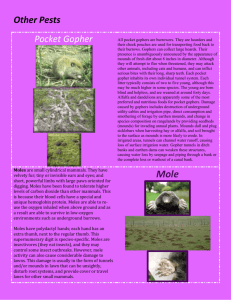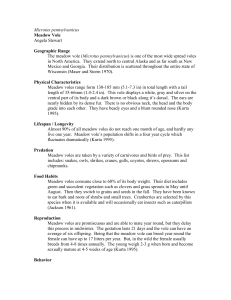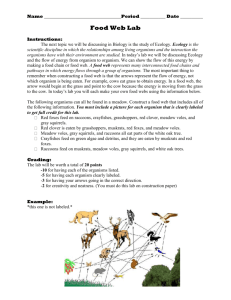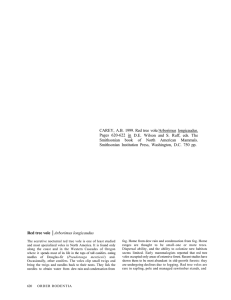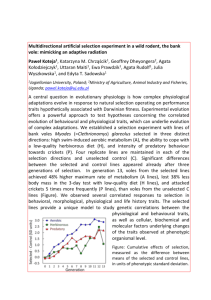Managing Vole Damage in Forest Plantations
advertisement
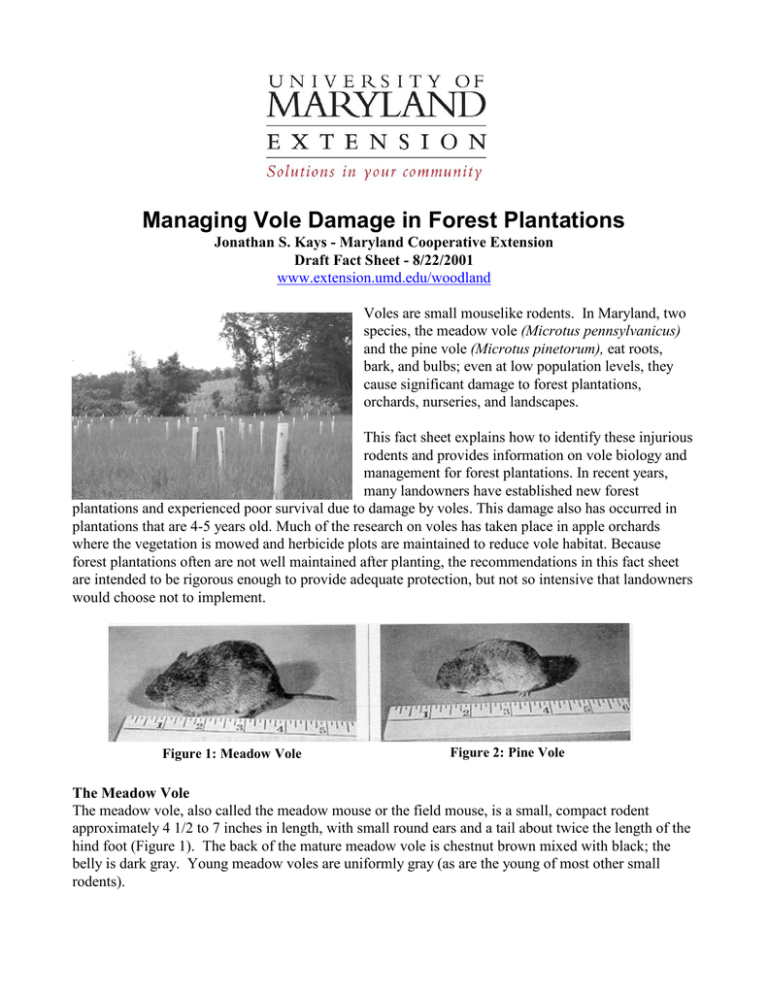
Managing Vole Damage in Forest Plantations Jonathan S. Kays - Maryland Cooperative Extension Draft Fact Sheet - 8/22/2001 www.extension.umd.edu/woodland Voles are small mouselike rodents. In Maryland, two species, the meadow vole (Microtus pennsylvanicus) and the pine vole (Microtus pinetorum), eat roots, bark, and bulbs; even at low population levels, they cause significant damage to forest plantations, orchards, nurseries, and landscapes. This fact sheet explains how to identify these injurious rodents and provides information on vole biology and management for forest plantations. In recent years, many landowners have established new forest plantations and experienced poor survival due to damage by voles. This damage also has occurred in plantations that are 4-5 years old. Much of the research on voles has taken place in apple orchards where the vegetation is mowed and herbicide plots are maintained to reduce vole habitat. Because forest plantations often are not well maintained after planting, the recommendations in this fact sheet are intended to be rigorous enough to provide adequate protection, but not so intensive that landowners would choose not to implement. Figure 1: Meadow Vole Figure 2: Pine Vole The Meadow Vole The meadow vole, also called the meadow mouse or the field mouse, is a small, compact rodent approximately 4 1/2 to 7 inches in length, with small round ears and a tail about twice the length of the hind foot (Figure 1). The back of the mature meadow vole is chestnut brown mixed with black; the belly is dark gray. Young meadow voles are uniformly gray (as are the young of most other small rodents). Meadow voles live in grassy habitats where they construct a complex network of surface runways. To identify active runways, look for clipped grass and small piles of droppings that resemble green or tan grains of rice. Nests are well-formed balls of interwoven dry grass, usually built at ground level. Where ground cover is sparse or on recently cultivated sites, meadow voles sometimes dig burrows and nest underground. The Pine Vole The pine vole, also called the pine mouse, spends nearly all of its life in an extensive system of trails and burrows located 1 inch to 2 feet below ground. The adult pine vole is smaller than the meadow vole, approximately 4 to 5 inches long, with a shorter tail, smaller eyes, and a more blunt nose (Figure 2). Pine voles have smooth chestnut brown fur on their back, but with no black shading. Table 1. Size and Appearance Meadow Vole Long body (150-195cm) Long tail (about twice the length of hind lengs: 3365mm) Prominent eyes and ears Fur coarse Color of upper body dull gray to chestnut, gray below Weight about 0.7-2.3 oz. Pine Vole Short body (110-135cm) Short tail (about equal to the length of hind legs: 15-26mm) Sunken eyes and ears Fur fine and velvety Color of upper body bright chestnut, slate gray below Weight about 0.7-1.3 oz. Characteristics of Activity Meadow Vole Girdle tree above ground and damage roots below ground surface Mostly active above ground, but will create subsurface trails Food stored just below surface trails Droppings litter surface trails Pine Vole Damage roots below ground surface Subsurface trails, rarely active above ground Food cached in underground trails Droppings litter underground runways Mounds of soil in burrow openings Moles and Shrews Moles and shrews may be confused with voles, and they are caught occasionally in traps set for voles. Unlike voles, moles and shrews primarily feed on insects and worms in the soil and do not damage plants, but moles can dislodge bulbs and sometimes cause them to dry out as a result of their digging. In fact, they can be beneficial predators because they feed on pest insects, such as Japanese beetle grubs. However, moles often are viewed as pests because their raised tunnels in lawns are considered unsightly. Moles can be identified by their large front feet and claws and by their outward facing palms. Shrews have a pointed snout and short tail. White Footed Mice White-footed mice (Peromyscus leucopus) and deer mice (Peromyscus maniculatus) are commonly found nesting in tree shelters in forest 2 plantations and many landowners and foresters may determine that they are responsible for girdling and killing tree seedlings and saplings. While mice may gnaw and girdle some parts of the stem above the ground, they typcially feed on seeds, not woody tissue, and do not kill many trees. They do not eat and girdle roots below the ground, as do voles. If the nests are found in the shelters, they should be removed. Both mice look similar, with large ears, rounded and mostly hairless bodies, and eyes that are large and bulging. They are 6 to 8 inches in length with the tail about 1/2 the total length. They can be told apart by the tail. The tail of the deer mouse is bicolored, the top half being slightly darker than below. Vole Biology Vole populations vary greatly from year to year, depending on climate, food, habitat availability, disease, rodenticide use, and the presence of predators. Like most rodents, voles are prolific breeders. Meadow voles produce 5 to 10 litters per year, with an average of five young per litter (Figure 1); gestation is approximately 23 days. Females sometimes will mate the same day their young are born. Pine voles produce fewer litters than meadow voles and average only 3 or 4 young per litter. However, pine voles probably have a higher survival rate because they live underground, which helps protect them from predators. Young voles grow rapidly, are Figure 3. Vole tunnel hole and roots of weaned at only 2 to 3 weeks, and are sexually mature seedling eaten. Evidence of pine voles. within a month or two. Thus, if habitat is available, Seedling was covered by a tree shelter. voles can increase to damaging levels within a single growing season. The economic threshold for damage by voles is at a very low population level. A single animal living near a tree or shrub may cause sufficient damage to kill the plant or reduce production or landscape values. Population densities are not uniform which makes it difficult to predict the likelihood for damage. Voles are herbivores that cause considerable plant damage. During the growing season they eat green, succulent vegetation and fruits. During the fall, winter, and early spring, they feed on roots, stems, and bulbs. Strawberry plants, most trees and shrubs (including apple trees and pine seedlings), and herbaceous ornamentals are subject to vole feeding. Ornamental bulbs, such as tulips, also are favorite foods. Voles feed on both roots and stems of herbaceous flowering plants. Voles kill trees by girdling them, eating the bark at ground level, as well as the roots (Figure 3). Small seedlings in commercial forests and Christmas tree plantations sometimes are pulled down into vole tunnels and consumed entirely. Although tree shelters provide trees good protection against many other herbivores, they also offer voles protection from predators. Are Voles Present and Which is Which? Assessing the presence of voles should be done during the initial inspection of the planting site. By just walking through a potential or established forest plantation, you won't be able to see much evidence of 3 vole activity unless you get down on your hands and knees and pull back all that grass or other ground cover. In an established planting site, remove several tree shelters and pull back the vegetation found around each seedling. First, check the seedling itself for evidence of girdling of the bark. Pull up on the seedling to make sure it is firmly rooted. In many cases, the voles will have eaten away the majority of the roots below ground, even though the upper stem looks okay and the leaves still may be green. Now, start at the base of the seedling and work your way out away from the stem in all directions. If you find any well-worn trails about 3/4 to 1-1/2 inches in width meandering along the ground surface, you've found the characteristic sign of meadow voles. If you find small holes (about 1" diameter) near the seedling and a few feet out with small piles of soil near these holes (but no real evidence of trails), you could have either meadow or pine voles, but most likely it is the latter. However, just because you've found this evidence provides no indication of whether the trail or burrow system is active or has been abandoned. If you notice small rootlets, mold, or fine grass shoots growing in the trail, chances are it has been abandoned. Vole droppings (feces), small fresh grass clippings, or stored food materials along the trail, are good indicators of recent vole activity. Because the home range (area of daily activity) of a vole typically falls within the area covered by only a few trees, you cannot assume that voles are not present in other areas of the plantation if you didn't find any evidence by simply looking only at 1 or 2 trees. Simply finding evidence of vole presence does not indicate whether that population is large enough to be considered a problem to your operation or just an annoyance. To make that determination, you must monitor vole populations periodically. Assessing Vole Populations and the Extent of Damage To affect proper management of vole populations and the damage caused by them, you must implement a monitoring program. Most monitoring programs have been developed for use in apple orchards, where voles have a long history of causing damage. However, many forest plantations are in areas where there are no apples and these techniques may have to be modified slightly (i.e., it may take longer than 24-hours period for voles to find the bait and eat it). Rather than using apples as bait, peanut butter works well. Its strong smell attracts rodents and its longevity can be enhanced by mixing in oatmeal or a small amount of birdseed to make a paste. The mixture can be spread on a 2-inch square piece of the shingle and evaluated like a piece of apple based on how much of the mixture is eaten off the shingle. There are several ways to develop a monitoring program by using the: 1) Apple Activity Index (AI), 2) the Feeding Activity Index (FI), or 3) periodic trapping. The first two methods are quite similar, but offer slight variations in the usefulness of the end product. Trapping is more time consuming, labor intensive, and has a tendency to underestimate vole numbers and thus may not provide a reliable assessment of the size and status of your vole population. However, it is the best technique to use to distinguish between the species (you will capture an individual that will allow in-hand identification). Apple Activity Index (AI) The Apple Activity Index (AI) was first presented by Dr. R. E. Byers of the Virginia Polytechnic Institute in the early 1970s as a means to quickly assess the presence or absence of voles and also 4 estimate the potential severity of their activity within orchards. The AI technique has been adapted in this fact sheet for use in forest plantations. It does necessitate spending some time and labor effort, but the amount usually is not significant and represents time well spent. In this technique, as originally developed by Dr. Byers, monitoring stations are established throughout the orchard which are checked periodically to gauge the status of the vole population. Every third or fourth tree in the orchard is monitored by locating two stations on opposite sides of the tree. In forestry applications there are many more trees per acre and a single station per tree selected for monitoring should suffice. It is important to establish enough stations per acre to have reliable knowledge of where voles are active, and if they are controlled by whatever efforts you may implement. For simplicity, it is best to establish permanent monitoring stations during the initial site assessment prior to planting that can be used for many years, or until crown closure occurs. To be effective, you should think about establishing 10 monitoring stations per acre, evenly spaced throughout the plantation. Establish them in rows to ease location and monitoring. This amounts to a grid pattern of one station every 43 feet. Roofing shingles or pieces of wood or metal can be used for monitoring stations (Figure 4). Roofing shingles are composed of three sections that can be separated and used to establish monitoring stations. Tires that are cut in half longitudinally and placed open side down also work well to monitor voles and can be used as bait stations later if needed. However, obtaining large numbers of these is not costeffective compared to roofing shingles that are affordable and easy to use. Find the most active runways or holes and place a 1"-thick slice of apple (Figure 5a) or a 2"-square piece of shingle treated (Figure 5.) with peanut butter ("baited shingle") in the runway or adjacent to a hole at each station. If using apples, you just carve wedges of apple that are approximately 1-inch wide on the outside skin as you walk from station to station. Many produce managers at grocery stores will sell outdated apples for a low cost. Cover the bait and runway or hole with a shingle and mark its location with flagging to facilitate finding them later. After a 24-hour period, check each apple or baited shingle at each site for signs of voles feeding (tooth marks). At some of the more active sites, an entire apple slice or bait on the shingle may be consumed or stored by voles. Therefore, you must 5 record both the evidence of tooth marks and slices that have been removed. Because "baits" are relatively small in size, it is essential to properly cover each site to prevent other animals from feeding on or removing apple slices. In forest plantations, voles may not be accustomed to apples or other baits and it may take a number of days for them to find the bait and feed on it. If no activity is seen after 24-hours, it is wise to revisit the site 1 or 2 days later to recheck the baits. Figure 5a. Slices of apple can also be used to bait monitoring stations. Figure 4. A roofing shingle can be used to cover bait for monitoring the population. At its most simple level, this technique tells you which areas of the plantation have active vole populations. To gauge the extent of population activity over the entire plantation, divide the total number of stations by the number of stations where apples or baited shingles had been fed on (i.e., calculate what percentage of the plantation supports Because of Figureactive 5. Baitpopulations). shingle with peanut butter the explosive breeding potential of voles, an index used to bait a monitoring station greater than 20-25% may indicate a potential for serious damage and a need for vole management. Feeding Index (FI) To more accurately assess vole abundance, and thus the potential for damage, Dr. L. R. Askham at Washington State University refined the AI to include a more objective estimate of feeding activity and called the new method the Feeding Index (FI). The amount of feeding on each apple slice (or bait shingle) is broken into 1 of 5 categories and is used to predict population abundance and damage potential. The categories of feeding activity are defined, and an example is given in Tables 2 & 3. The technique was originally developed for apple orchards but the ranking system has been adapted for use in forest plantations using either apple slices or baited shingles. Given the larger acreage of some forest plantations, forest landowners will have to experiment with this technique. However, a minimum sample should include: 1) using one monitoring station per tree, with; 2) 10 stations per acre that are evenly distributed. This would amount to one station every 43 feet on a square grid pattern. Once you have visited and inspected all stations, the total number of apple slices or bait shingles that fall in each category is multiplied by Table 2. Feeding categories their category value (e.g., 7 slices in category 4 = 28). Add these values Category % of Apple or Bait Population FI Ranking Value Shingle Consumed Ranking together, and then divide by the total 0 None 0 number of stations to obtain a rating 1 <25% Low <1.0 for the plantations as a whole. The following example shows what a 2 25-50% Moderate 1.0-1.9 typical assessment worksheet might 3 51-75% High 2.0-2.9 look like in an forest plantation. 4 >75% Severe 3.0-4.0 6 Table 3. Feeding Index calculation 50 monitored stations in plantation 50 apple slices or bait stations distributed (@ 1 station per tree) 0 x # Slices or Shingles/Category 10 1 x 14 = 14 2 x 9 = 18 3 x 10 = 21 4 x 7 = 28 Category Value FI = 0 50 81 81/50 = 1.6 = Moderate population ranking When several assessments are made over a period of months (using the same monitoring stations during each trial), you have an index as to whether the population is increasing, decreasing, or staying about the same. The consumption of apples or peanut butter on bait shingles in different parts of the orchard can indicate areas in greater need of treatment. The FI indicator can be used to determine when and what type of control to employ in the plantation. Trapping It is important to make a positive identification of a pine or meadow vole through trapping. Relying only on the presence of surface tunnels or underground runways can be confusing. In some cases, pine and meadow voles have been found using the same plantation. A set of traps, as well as monitoring stations, can be used during the initial site inspection and visited the next day to determine the species and activity. Traps should not be set near monitoring stations. The use of conventional snap traps is recommended because they are inexpensive and easy to use. Vole populations may shift from one part of the plantation to another, therefore, you need to lay out a grid of traps that will cover the entire plantation. Intensive trapping is not likely to be implemented by foresters or landowners, but a minimum of 10-12 traps per acre is recommended. A caution needs to be mentioned here. Because pine voles spend so little time at or near the surface, traps placed on the surface most likely will not capture them, even where they are present. First, you must find their subsurface burrows (look for holes or probe with your fingers about 2-3" deep at the dripline of a tree, deeper near the bole). Then excavate an area of sod or soil large enough to accommodate a standard wooden-based mousetrap so that a trap placed in this opening will be flush with the bottom of the underground runway. Try not to disturb the trail system too much during excavation. Place the trap perpendicular to the trail with the trip pan in the center of the trail. Traps should be baited with peanut butter. Cover each trap site with a shingle to prevent other animals from tripping the trap and to facilitate locating trap sites 24 hours later. Be sure to record your catch at each station accurately, including which species was captured and the number of individuals of each species caught. Results from trapping often can provide an indication of whether the composition of the vole population is changing (e.g., are the numbers of pine voles going up while meadow voles go down?). It also can be used to detect the spread of a vole infestation within the plantation area. Voles can quickly invade from surrounding areas to repopulate an area where vole populations have been controlled. Another type of trap is the Sherman trap, which is a collapsible metal trap that is baited with apple or peanut butter. The vole goes into the trap and is captured alive. Sherman traps can be purchased for about $15 each from forestry and/or wildlife supply companies. They work quite well for meadow voles, but may be less effective for the more secretive pine vole. 7 Dead rodents and traps must be handled carefully. Serious respiratory diseases in humans (e.g. hanta virus) in the Southwest and Florida and other states have been attributed to microorganisms found in rodent feces and urine. The deer mouse (Peromyscus laucopus/maniculatus), common in Maryland, is considered a possible vector for these diseases, but voles, as of yet, have not been identified as vectors. When handling dead rodents and traps, it is very important to wear disposable gloves, and wash hands well afterward. Treat all dead rodents and traps as possible carriers of disease. Bury the dead rodents immediately. Traps should be washed and disinfected. Managing the Damage There is no "magic pill" for vole control; no single, simple remedy solves the problem. Following positive identification of the rodent, integrated pest management (IPM) - the appropriate combination of habitat reduction, trapping or poison baiting, and predators - is the best known approach to reducing vole populations (Figure 6). Monitor vole sites in early spring and again each fall to detect rising numbers before plants are damaged. In many situations, natural resource managers conduct surveys to estimate survival in forest plantations during in the fall. Many landowners are surprised to find a high mortality rate compared to survival the previous fall. If a check of monitoring sites and visual assessments indicates high vole populations, then vole populations can be reduced that fall using a rodenticide to minimize winter losses. It is imperative that vole populations be monitored prior to any replanting of new trees. If voles are present at high populations, replanting without treatment is a waste of time and money. Once a high vole population has become established, poison baits or rodenticide treatments are the quickest and most effective way to control them. Habitat Reduction Trees planted in old fields, pasture, and other areas with permanent sod cover are more likely to have existing vole populations, so reduction of ground cover is essential to manage vole populations. Any accumulation of vegetation about the base of the tree will provide ideal habitat. Tree shelters can provide excellent cover for voles, but the addition of thick vegetation around these shelters only increases the problem. Figure 6 Figure 6. Integrated Pest Management 8 A general rule of thumb to follow is to remove all vegetation within 3 feet of the tree (either as a circle or strip. This can be accomplished by cultivation or careful use of an approved herbicide. Be sure to remove all remaining dead plant material; even though it's dead, it still provides standing cover. This is a problem in older plantings that have not been maintained and then are treated with herbicide. Vegetated strips between rows should be mowed frequently. Because you are not likely to get rid of all the voles, you want to try to confine them to the strips - not by the trees. If adequate food exists within the strips to support that portion of the population that you can't eliminate, they normally will not venture out into the open. However, monitoring of the population is necessary. Herbicides suitable for orchards, nurseries, or forest plantations can be used to clear vegetation from a 4-foot circle at the base of trees in the fall to help keep voles away from the tree trunks and tree shelters. Be careful not to leave a depression when removing weeds from under young trees. It may hold water that could freeze and suffocate roots. Where a heavy growth of vegetation is present, herbicide applications should be timed to prevent a thick accumulation of dead material, which could harbor mice. If possible, rake off leaves and grass from around trees. If clearing around trees is not possible, frequent mowing will be helpful. Even if areas around trees are cleared, frequent mowing of areas between trees will help to further reduce protective cover for voles. Many orchard growers protect young tree trunks from meadow voles by embedding cylindrical wire guards around the trunk and up to 3 inches into the soil at its base. Voles may still be able to get inside the wire, but it may provide some protection. This is not practical for most forest plantings, especially where trees shelters are used. However, wire guards may be practical in smaller forest plantings. Wire guards should be taller than the average anticipated snow depth so that voles cannot crawl over the top and girdle the stems in winter. Guards are less effective against pine voles because they can tunnel under the guard. These guards usually are made from 1/4-inch mesh galvanized hardware cloth. Bend the wire mesh into a cylinder large enough to allow for 5 years' growth. After the guard is in place, use three short pieces of wire to secure an overlap of approximately 1 inch. Installing guards when planting minimizes damage to tree roots. Check guards in the fall to be sure their bases are still buried properly. Other materials, such as rolled roofing, aluminum foil, sheet metal, and specially made plastic spiral wraps, are also used for tree guards. However, none of these are as satisfactory as wire mesh. Predators Encouraging vole predators often is underestimated as a control measure. It is true that many predators are not present until voles already have reached damaging levels; however, encouraging predators can form the basis for long-term control. House cats can eat voles all year long, but free roaming cats can also reduce native bird populations. Hawks, owls, and crows also feed on voles. Great blue herons also feed on voles, however, they are usually located near bodies of water. Owls hunt at night, whereas hawks and crows hunt in the daytime; all consume large numbers of small rodents. In many landscapes, a lack of proper perch sites overlooking vole-infested areas limits the effectiveness of hawks, owls, and crows because they hunt by scanning the ground from a perch, then swoop down to capture prey. Installing a perch can assist in long-term rodent control. A perch can be constructed using a wooden pole properly secured in the ground, with a 2- to 3-foot cross tee at 8 to 10 feet above the ground. One or two per acre spaced to provide maximum viewing of the ground area should suffice. 9 Black snakes and king snakes also are highly effective predators of small rodents, and they do not harm humans. They should not be killed or disturbed if seen. Fox and coyote are also known predators of voles. Chemical Treatment Commercial rodenticides can be used in situations where vole populations must be reduced quickly to minimize loss of trees or prepare a site for planting. If an initial monitoring of the planting site indicates high vole populations, rodenticides can be used to reduce the population and then vegetation management (mowing, herbicide strips) can be employed, along with monitoring, to keep the vole population in check. If you are preparing to plant trees in an old field or pasture, it is likely that voles are present and they must be monitored to determine if pretreatment of the site with rodenticides is necessary to reduce the population. Rodenticides are available from agricultural supply stores (Figure 7). Over-the-counter formulations vary widely in their effectiveness. In Maryland, and most other states, you must have a certified commercial pesticide applicator's license (not a regular private applicators license) in order to obtain and use the most effective rodenticides. When using poison baits, always follow the instructions on the label carefully to avoid injury to yourself, other people, or pets and wildlife. Rodenticides are classified as either acute or chronic in their action. Acute rodenticides (e.g., zinc phosphide) are fast-acting poisons that usually will kill voles quickly after one feeding. Zinc phosphide works by forming a phosphine gas in the stomach of the rodent after it is consumed. The gas kills instantly and then dissipates so there is no incorporation into muscle tissue. This minimizes problems of Figure 7. Rodenticides secondary poisoning of predators that may feed on voles. The bait is sold in a pelletized form or mixed with grain. The pelletized form usually lasts longer and is more widely used. In contrast, chronic rodenticides, which include most anticoagulants, require multiple feedings over a period of about 5 days to kill voles. Unlike for zinc phosphide, there is an effective antidote for most chronic rodenticides: Vitamin K1. Anticoagulant toxicants are available to certified pest control applicators through pesticide distributors. When you use poison baits on a regular basis, it is suggested that you rotate rodenticides so that voles do not develop bait shyness, a common problem with zinc phosphide. Both acute and chronic rodenticides are available in pelleted bait formulations, which are superior to grain baits because they are more effective against voles and are not as hazardous to ground-feeding birds and other nontarget wildlife. Acute rodenticides are more widely used in forest plantings due to their quick activity. 10 Timing can affect the success of a poison-bait program. The optimum times to apply poison baits are in the fall and in the winter and early spring. Early spring applications can reduce populations before most females begin breeding for the year, but vole populations can quickly recover before the next winter. As the spring progresses and natural foods become more abundant, baiting becomes less effective. During the fall, bait acceptance increases again. Late fall applications reduce vole populations just before winter, when these pests do the most damage. Unfortunately, voles may reinvade quickly from surrounding areas and may still cause significant winter damage, especially under the cover of snow. Winter is an ideal time to deliver bait, when most damage occurs and bait acceptance is greater as a result of natural food shortages. The bait should be kept dry and protected from adverse weather conditions. Bait placement is critical to the success of a rodenticide program. The contrasting living habits of meadow and pine voles have important implications for their detection and control. Dispersing bait over an entire area, or broadcast baiting, is more effective against meadow voles because they live on the ground and forage more widely than pine voles. However, in most forestry applications the tall grass may make broadcast baiting less effective, unless the grass is mowed first. The bait may have difficulty getting through the ground cover to a place where the voles will reach it. Instead, it tends remain suspended in the grass or brush, get wet quickly, and lose effectiveness. Also, broadcast baiting significantly increases the opportunity for non-species to eat the bait. For these reasons, it is recommended that hand baiting or bait stations be used. A major problem with all baits is that they quickly absorb moisture, and many applications do not last for more than a week. Placing bait for pine voles in tunnels, or under roofing shingles, slabs of wood, split automobile tires, or other similar materials with help protect the bait from moisture and non-target species. Bait stations placed above active runways or tunnels give the best results for pine and meadow voles. If tree shelters are used in the tree planting, bait can be placed in the shelter or alongside it at regular spacings to cover the site. An effective bait station can be constructed from an automobile tire split in half longitudinally. Tire splitters are available commercially, or local tire companies can split tires at a nominal cost. Arrange tire halves hollow-side down, and distribute one per tree or one every 10 yards throughout the infested area. There is no need to provide entrances. Place bait in small cups under the tires. The rounded shape of the tire prevents moisture from dripping into the bait cup, and heat inside the tire can help to attract the voles. Another bait station design consists of three pieces of 40-gauge, 1 1/2-inch-diameter PVC tubing joined in the shape of an inverted "T" by a PVC tee joint. The bait station is installed so that the horizontal piece is below the ground and follows existing vole tunnels (Figure 8 - shown above ground). The vertical tube is 12 inches long and covered at the top with a PVC cap or 12ounce soft drink can opened at one end to keep out rain and snow. Each of the bottom horizontal pieces is 6 inches long with the outside end cut at a 45-degree angle. The pieces are cemented together with PVC cement. Bait is placed in the vertical tube, and voles enter through the side tubes that intersect 11 Figure 8. PVC bait station shown not installed in ground underground tunnels and feed. Each station may be secured to a tree with rope and placed in natural or manufactured tunnels. If extra support is needed to hold the bait station vertically, stakes can be inserted in the ground along the sides. This bait station has been effective in some Northeastern apple orchards during winter and early spring. About 5-7 bait stations per acre are recommended. It has not been tested in forest plantations but can likely be of value when dealing with large populations of pine voles that are secretive, underground, and hard to attract to aboveground bait. Evaluating the Success of Treatment Many landowners who have experienced a problem with voles and then applied some form of control, never conduct a follow-up to see if their treatment had any impact on vole numbers. One treatment may not be sufficient to manage a severe infestation of voles. Monitoring treatment effects is quite easy and simple. In fact, simplified versions of the original assessment techniques (AI, FI, Trapping) will fulfill this need. One method involves placing bait shingles or apple slices at 10 more sampling stations in an area containing active runs before treatment begins. Count the number of slices/shingles that were chewed overnight and calculate a percentage using the total number of sampling sites (e.g., 5 of 10 slices/shingles chewed = 50%). Wait one week and repeat the process using the same sites, if possible. Check the slices/shingles the next morning and recalculate your percentage (e.g., 3 of 10 slices/shingles chewed = 30%). The reduction in the vole population is determined by calculating the change in percent (i.e., 50% to 30% = 20% reduction). Traps can also be used to monitor population reductions. Prepare and bait traps as outlined earlier. Set your traps just prior to and just after treatment. If voles are captured at more than 1 or 2 sites, reapplication may be warranted. Voles will continue to breed into late fall and early winter. Remember that voles remain active especially when the weather remains mild. Also, these animals remain active throughout the winter beneath the snow. Therefore, don't feel comfortable that an early treatment will eliminate your problem for the entire winter. You may want to periodically look for evidence of voles throughout the winter by watching for tunnels in the snow. You can hand-bait these trails throughout the winter to maintain some level of control. Another factor to consider is reinvasion of voles from adjacent fields after a chemical treatment. Research in apple orchards indicates that less than a year after treatment, voles may reinvade a site in significant numbers. In forest plantations a similar reinvasion can be expected. Acknowledgments • Figures 1 & 2 were provided by Ross E. Byers, Extension and research horticulturist, Department of Horticulture, Virginia Tech, Blacksburg, VA. • Publication reviewed by Jim Parkhurst, Extension Wildlife Specialist, Department of Wildlife and Fisheries, Virginia Tech, Blacksburg, VA. Thanks to the authors of the following publications, which helped form the basis of this fact sheet: • Bromley, P., R. Byers, and S. MacPherson. 1988. Wildlife damage control in Virginia: Controlling voles. Publication No. 420-024. Blacksburg, VA: Virginia Cooperative Extension Service. • Caslick, J.W., and D. J. Decker. 1978. Control of wildlife damage in orchards and vineyards. Bulletin 146. Ithaca, NY: Cornell University. 12 • • • • • Curtis, D. C., M. J. Fargione, and M. E. Richard. 1994. Wildlife damage management in fruit orchards. Bulletin 236. Ithaca, NY: Cornell University. Parkhurst, J.A. Date Unknown. Recognizing, assessing the extent of, and controlling damage causing by voles in orchards. University of Massachusetts, Amherst, MA. Tobin, M. E., and M. E. Richmond. 1987. "Bait stations for controlling voles in apple orchards." Proceedings of the Eastern Wildlife Damage Control Conference. 1: 287-295. Tobin, M. E., and M. E. Richmond. 1992. "Comparison of methods for detecting voles under apple trees." Proceedings of the Eastern Wildlife Damage Control Conference. 5: 201-204. Tobin, M. E., and M. E. Richmond. 1993. Vole management in fruit orchards. Washington, DC: U.S. Fish and Wildlife Service. References • Byers, R. E. 1975. A rapid method for assessing pine vole control in orchards. HortScience 10: 391-392. • Byers, R. E. 1982 (August-September). Economics of Microtus control in eastern U.S. orchards. In Proceedings of the annual meeting of the Organization and Practice of Vertebrate Pest Control. New Hampshire, England: ICI Plant Protection Division. • Byers, R. E. 1984. Control and management of vertebrate pests in deciduous orchards of the eastern United States. Horticultural Reviews 6: 253-285. • Byers, R. E., and D. H. Carbaugh 1989. Vole population shifts related to rodenticide usage. HortScience 24(5): 783-785. • Byers, R. E., and D. H. Carbaugh. 1991. Rodenticide for the control of pine and meadow voles in orchards. Journal of Environmental Horticulture 9(3): 167-172. 13

